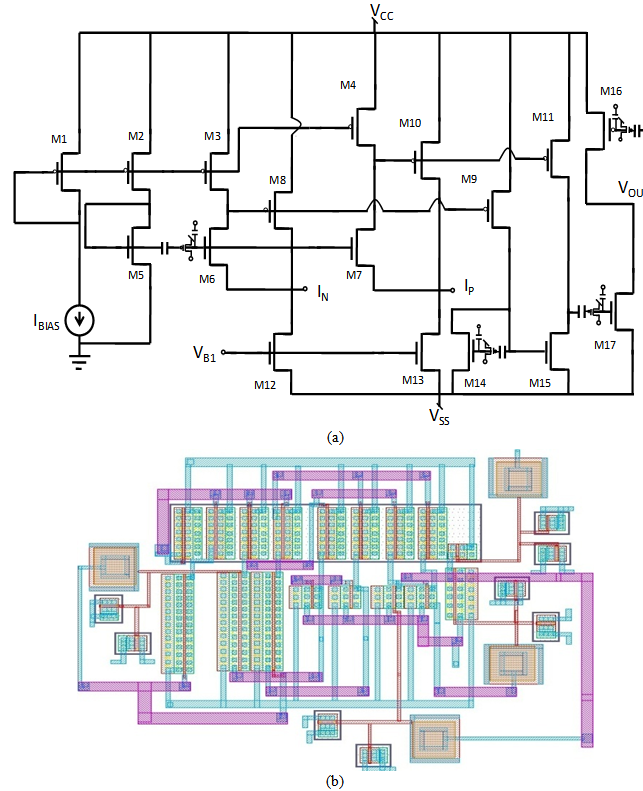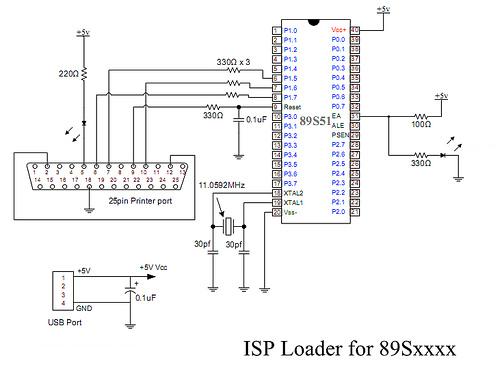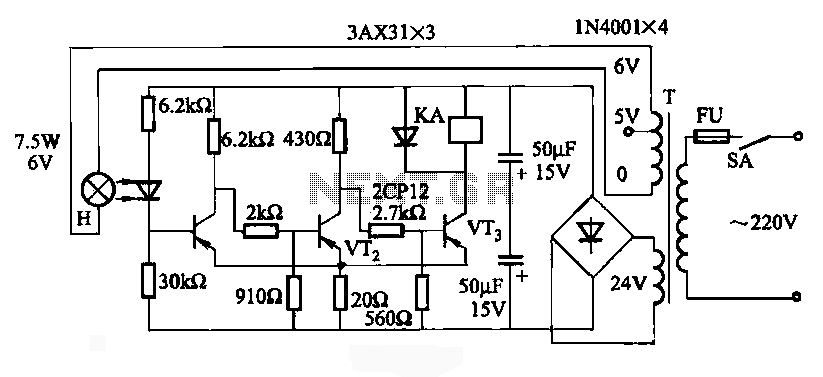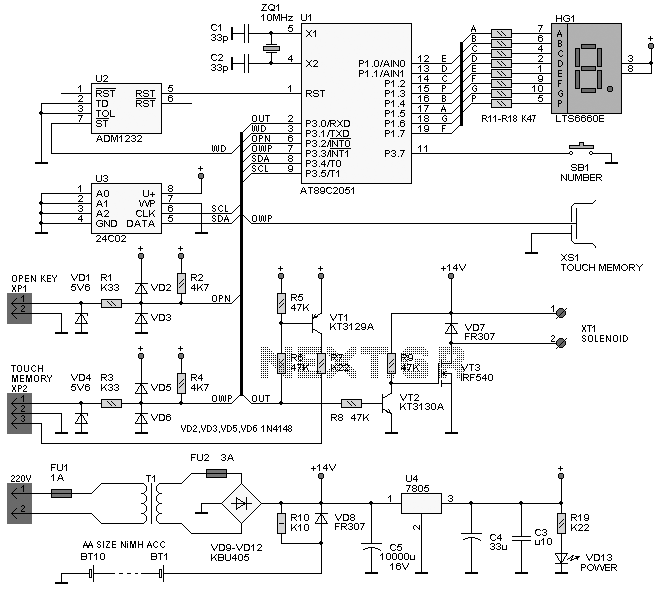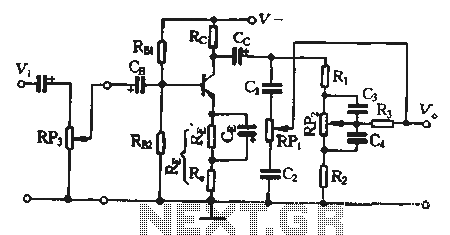
MOSFETs IN SERIES
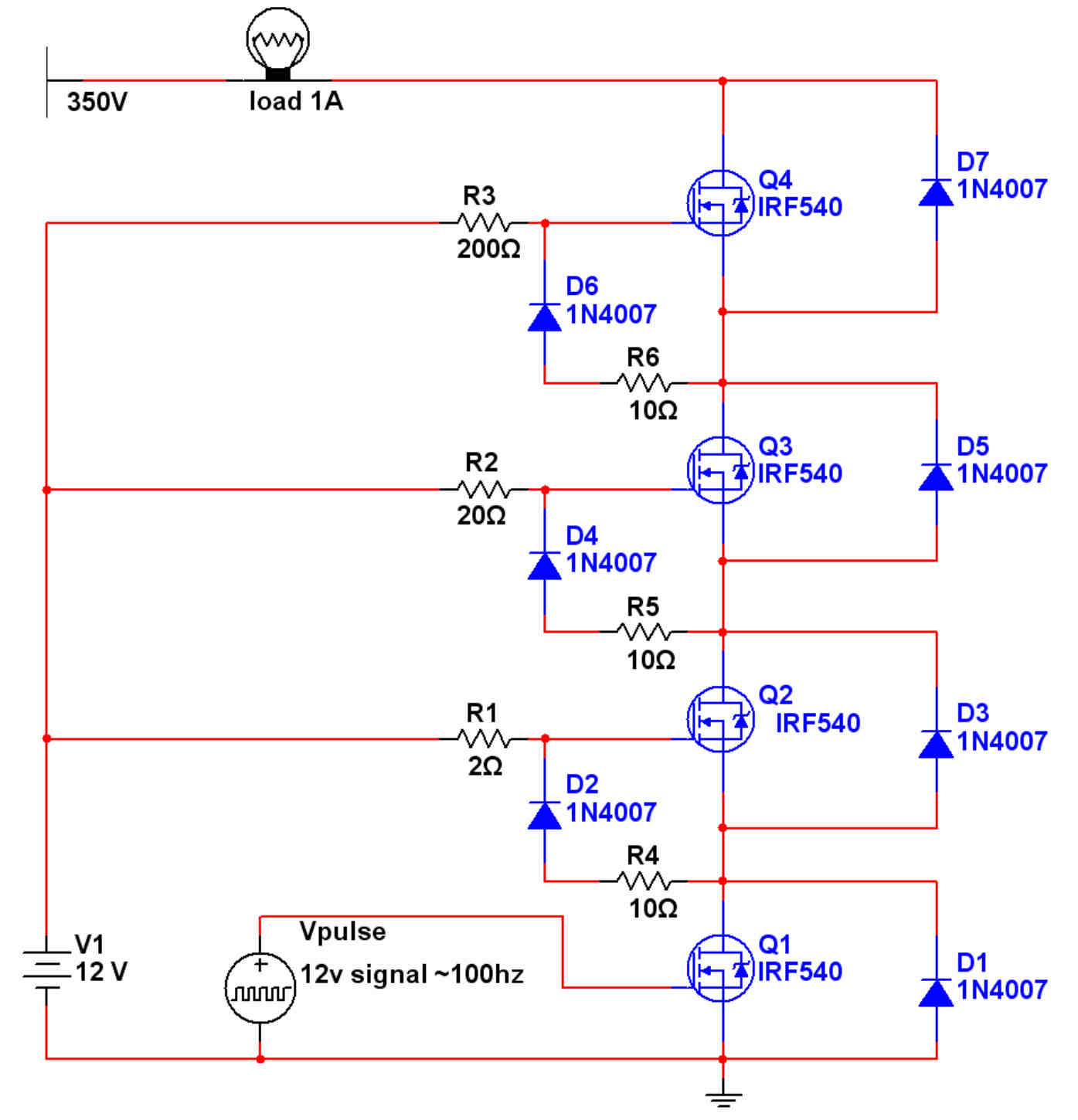
Some time ago, a document was encountered that explains how to wire MOSFETs in series to achieve higher voltages (pages 10-14). This is the only schematic found to be functional so far. However, an issue arises when attempting to add a fourth MOSFET; it remains off regardless of the configuration. Various resistor values were tested, initially assuming that if R2 is 2 ohms and R3 is 20 ohms, the next should be 200 ohms. When this did not work, attempts were made with 20, 50, and 1k ohms, but to no avail. Input is requested on what might have gone wrong, with a suggestion to post the circuit and indicate the voltages used. It is advised to consider the voltage V3 mentioned in the document relative to V1. It is unlikely that the problem lies with resistor values. It is noted that a diode from the 12V DC supply to the MOSFET gates has been omitted. It is recommended to use an individual diode from the +12V supply to each gate and to replace the gate-source diodes with Zener diodes for protection. Concerns are raised about why this approach is necessary when MOSFETs capable of switching 350V are readily available. The issue is emphasized that the fourth MOSFET (Q4) is not switching on, leading to a simplification of the circuit as per the document's suggestions. It is reiterated that precautions should be taken to avoid damaging the MOSFETs. If the suggested changes (diodes to each gate and Zeners from gates to sources) do not resolve the issue, it may indicate incorrect wiring or a damaged MOSFET. If the problem persists, it is advised to post the voltages on all three terminals of each MOSFET. Caution is advised regarding the maximum Vdg for these MOSFETs, especially when all slave MOSFETs have their gates at essentially the same potential. Concerns about safety when working with high voltages are also expressed, suggesting additional precautions may be needed, and emphasizing that a fuse is primarily for fire prevention rather than electrocution protection.
When designing a circuit that utilizes multiple MOSFETs in series for voltage amplification, it is crucial to ensure that each MOSFET operates within its specified parameters. The primary goal is to achieve a reliable switching mechanism across all MOSFETs while maintaining proper voltage levels at each gate.
The proposed circuit configuration should include a dedicated diode connected from the +12V supply to each MOSFET gate. This diode serves to isolate the gate voltage and prevent backflow, ensuring that each MOSFET receives the appropriate gate drive voltage. The use of Zener diodes between the gate and source of each MOSFET is recommended to protect against over-voltage conditions that could lead to gate damage.
In this configuration, it is essential to monitor the gate-source voltage (Vgs) and drain-source voltage (Vds) for each MOSFET. The gate-source voltage should remain within the manufacturer's specifications, typically between 10V to 20V for optimal switching. The drain-source voltage must also be carefully managed to prevent exceeding the maximum ratings, especially when cascading multiple MOSFETs, as the cumulative voltage can approach or exceed the rated limits.
Additionally, a thorough verification of the circuit connections is necessary to rule out wiring errors. Each MOSFET's terminals should be checked for correct orientation and proper connections to the power supply and load. If the fourth MOSFET remains inactive, it is advisable to measure the voltages present at the gate, source, and drain terminals of all MOSFETs to identify any discrepancies.
Safety precautions are paramount when working with high voltages. An isolating transformer should be employed to minimize the risk of electric shock, and all components should be rated for the maximum expected voltages. Furthermore, it is advisable to employ proper personal protective equipment and to work in a controlled environment to mitigate any risks associated with high-voltage circuits.A while ago i run across this document which apparently tells how to wire mosfets in series to get higher voltages (pg 10-14). This is the only schematic i found so far that is actually working. The problem is that i can`t make more than 3 mosfets work, when i add a fourth ( with the same circuitry) it remains OFF no matter what.
I tried different resistor values. At first i though that if R2 has 2ohms and R3 20ohms that the next should be 200ohms. When it didn`t work i tried 20, 50 and 1k but with no luck. Can you please tell me what i did wrong You need to post your circuit and indicate voltages used, I would suggest looking at the voltage V3 mentioned in the paper relative to V1. I wouldn`t really expect there to be a resistor value problem with this circuit. I don`t think your circuit will work. You`ve omitted the diode from the 12VDC supply to the MOSFET gates. I would use an individual diode from the +12V supply to each gate, and I would replace the gate-source diodes with zeners to protect the gate.
Then I think it would work. But why are you doing this MOSFETs that can switch 350V are readily available. Hey i`m no expert but isn`t it a "protection" matter i may do it so not to blow up anything, but the problem is that i can`t make Q4 even switch on, thats why i stripped everything out to try it as the paper suggests. Hey i`m no expert but isn`t it a "protection" matter i may do it so not to blow up anything, but the problem is that i can`t make Q4 even switch on, thats why i stripped everything out to try it as the paper suggests.
Oh sorry. I foolishly thought that it would be helpful and important to prevent you from blowing up your MOSFETs. Of course, you can just add the zeners later, if you can be bothered. If you make the changes I have suggested (diode to each gate, and zeners from gates to sources), and the MOSFETs remain OFF when +12V is applied to the gate of the bottom one, either you`ve wired something wrong, or you have a damaged MOSFET.
If you can`t find the problem, post the voltages on all three terminals of each MOSFET. Looking more closely at this, I would be careful about exceeding Vdg for these mosfets. Whilst not often specified (but can be assumed to be Vds + Vgs), it is something you need to be careful about. This is especially true when all your slave mosfets gave their gates at essentially the same potential.
If you make the changes I have suggested (diode to each gate, and zeners from gates to sources), and the MOSFETs remain OFF when +12V is applied to the gate of the bottom one, either you`ve wired something wrong, or you have a damaged MOSFET. If you can`t find the problem, post the voltages on all three terminals of each MOSFET. Looking more closely at this, I would be careful about exceeding Vdg for these mosfets. Whilst not often specified (but can be assumed to be Vds + Vgs), it is something you need to be careful about.
This is especially true when all your slave mosfets gave their gates at essentially the same potential. Don`t worry that`s probably isn`t going to happen. I work with my left hand in the pocket, and i have a transformer and a fuse so even if i get a shock (don`t think so) it won`t be lethal.
Well. if you know of any other precaution i could take it would be good. Don`t worry that`s probably isn`t going to happen. I work with my left hand in the pocket, and i have a transformer and a fuse so even if i get a shock (don`t think so) it won`t be lethal. Well. if you know of any other precaution i could take it would be good. Do a Google search. A thorough one. And when you`re working with voltages of 500V or more, a transformer (I assume you mean an isolating transformer) may not help you.
And a fuse is no use at all - they`re there to prevent fires, not electrocution. 🔗 External reference
When designing a circuit that utilizes multiple MOSFETs in series for voltage amplification, it is crucial to ensure that each MOSFET operates within its specified parameters. The primary goal is to achieve a reliable switching mechanism across all MOSFETs while maintaining proper voltage levels at each gate.
The proposed circuit configuration should include a dedicated diode connected from the +12V supply to each MOSFET gate. This diode serves to isolate the gate voltage and prevent backflow, ensuring that each MOSFET receives the appropriate gate drive voltage. The use of Zener diodes between the gate and source of each MOSFET is recommended to protect against over-voltage conditions that could lead to gate damage.
In this configuration, it is essential to monitor the gate-source voltage (Vgs) and drain-source voltage (Vds) for each MOSFET. The gate-source voltage should remain within the manufacturer's specifications, typically between 10V to 20V for optimal switching. The drain-source voltage must also be carefully managed to prevent exceeding the maximum ratings, especially when cascading multiple MOSFETs, as the cumulative voltage can approach or exceed the rated limits.
Additionally, a thorough verification of the circuit connections is necessary to rule out wiring errors. Each MOSFET's terminals should be checked for correct orientation and proper connections to the power supply and load. If the fourth MOSFET remains inactive, it is advisable to measure the voltages present at the gate, source, and drain terminals of all MOSFETs to identify any discrepancies.
Safety precautions are paramount when working with high voltages. An isolating transformer should be employed to minimize the risk of electric shock, and all components should be rated for the maximum expected voltages. Furthermore, it is advisable to employ proper personal protective equipment and to work in a controlled environment to mitigate any risks associated with high-voltage circuits.A while ago i run across this document which apparently tells how to wire mosfets in series to get higher voltages (pg 10-14). This is the only schematic i found so far that is actually working. The problem is that i can`t make more than 3 mosfets work, when i add a fourth ( with the same circuitry) it remains OFF no matter what.
I tried different resistor values. At first i though that if R2 has 2ohms and R3 20ohms that the next should be 200ohms. When it didn`t work i tried 20, 50 and 1k but with no luck. Can you please tell me what i did wrong You need to post your circuit and indicate voltages used, I would suggest looking at the voltage V3 mentioned in the paper relative to V1. I wouldn`t really expect there to be a resistor value problem with this circuit. I don`t think your circuit will work. You`ve omitted the diode from the 12VDC supply to the MOSFET gates. I would use an individual diode from the +12V supply to each gate, and I would replace the gate-source diodes with zeners to protect the gate.
Then I think it would work. But why are you doing this MOSFETs that can switch 350V are readily available. Hey i`m no expert but isn`t it a "protection" matter i may do it so not to blow up anything, but the problem is that i can`t make Q4 even switch on, thats why i stripped everything out to try it as the paper suggests. Hey i`m no expert but isn`t it a "protection" matter i may do it so not to blow up anything, but the problem is that i can`t make Q4 even switch on, thats why i stripped everything out to try it as the paper suggests.
Oh sorry. I foolishly thought that it would be helpful and important to prevent you from blowing up your MOSFETs. Of course, you can just add the zeners later, if you can be bothered. If you make the changes I have suggested (diode to each gate, and zeners from gates to sources), and the MOSFETs remain OFF when +12V is applied to the gate of the bottom one, either you`ve wired something wrong, or you have a damaged MOSFET.
If you can`t find the problem, post the voltages on all three terminals of each MOSFET. Looking more closely at this, I would be careful about exceeding Vdg for these mosfets. Whilst not often specified (but can be assumed to be Vds + Vgs), it is something you need to be careful about. This is especially true when all your slave mosfets gave their gates at essentially the same potential.
If you make the changes I have suggested (diode to each gate, and zeners from gates to sources), and the MOSFETs remain OFF when +12V is applied to the gate of the bottom one, either you`ve wired something wrong, or you have a damaged MOSFET. If you can`t find the problem, post the voltages on all three terminals of each MOSFET. Looking more closely at this, I would be careful about exceeding Vdg for these mosfets. Whilst not often specified (but can be assumed to be Vds + Vgs), it is something you need to be careful about.
This is especially true when all your slave mosfets gave their gates at essentially the same potential. Don`t worry that`s probably isn`t going to happen. I work with my left hand in the pocket, and i have a transformer and a fuse so even if i get a shock (don`t think so) it won`t be lethal.
Well. if you know of any other precaution i could take it would be good. Don`t worry that`s probably isn`t going to happen. I work with my left hand in the pocket, and i have a transformer and a fuse so even if i get a shock (don`t think so) it won`t be lethal. Well. if you know of any other precaution i could take it would be good. Do a Google search. A thorough one. And when you`re working with voltages of 500V or more, a transformer (I assume you mean an isolating transformer) may not help you.
And a fuse is no use at all - they`re there to prevent fires, not electrocution. 🔗 External reference

